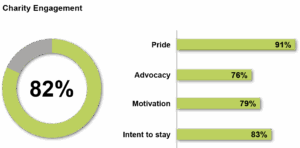Engagement in the Charity Sector
Engagement is central to the success of charitable organisations. By having volunteers and employees who are highly engaged, charities can better manage the ever-changing socio-economic landscape and ensure that resources deliver the desired impact. A highly engaged workforce not only builds a trusting, productive environment but also one where individuals are willing to go the extra mile to contribute to the shared goals of the organisation. Thanks to our extensive benchmark database, gathered from working with well-known UK and global charities, we are able to delve deeper into engagement and its key drivers within the sector.

From our in-house research, we can see that the charity sector has an 82% engagement level. This is 2% below our overall benchmark and lower than other sectors. By looking at the distinct variations amongst the key drivers of engagement – Pride, Motivation, Advocacy, and Intent to Stay – we can better understand engagement within the charity sector, where it outperforms and where it has room for development.
Pride
A high pride score demonstrates that employees or volunteers have an emotional connection to the organisation. It reflects the idea that they believe in the mission and values and feel aligned with the organisation’s culture. Those who are proud to work for an organisation are more motivated and productive. It can also result in employees or volunteers becoming brand ambassadors. As you might expect, pride is high in the charity sector at 91%. This is significantly higher than other sectors and 3% higher than our overall score. Given the sector’s strong sense of mission and purpose, it is unsurprising that individuals feel such pride.
Advocacy
Advocacy reflects both personal satisfaction and the willingness to speak positively about workplace experiences. A high advocacy score implies that employees feel valued and trust the organisation to treat people well. They also feel they have access to the resources and equipment needed to fulfil their role, making their day-to-day working life a positive experience. From our benchmark data, this is the lowest-scoring engagement driver for the charity sector at 76%.
On the surface, this may be surprising – why would individuals not recommend their charity as a place of work? But looking deeper, the low score becomes clearer. The charity sector has been hit hard recently: the cost of living crisis has reduced public donations, while inflation, increased running costs, and cuts to government funding have all placed significant strain on the sector. This inevitably has a knock-on effect on employees’ and volunteers’ day-to-day working experiences.
Motivation
A high motivation score shows a strong sense of purpose and meaning. Motivation is not only sourced from external rewards but also from alignment with an organisation’s mission. It signals that employees will go above and beyond in their role, being proactive in their contributions. Motivation for the charity sector sits at 79%, just 1% below our overall score. Whilst individuals possess a strong sense of purpose and emotional connection within the sector, motivation could be held back by high workloads, limited progression opportunities, and salaries that are less competitive than in other sectors.
Intent to stay
This reflects how connected and committed employees feel. A high score indicates overall satisfaction in the workplace, where employees feel valued, supported, and have access to career and personal growth opportunities. It also demonstrates belief in the future of the organisation, alongside high morale and trust in leadership.
Whilst 83% represents a positive score, this lags behind other sectors within our benchmark and is 3% below the overall score. This could be linked to the financial pressures facing the sector. Salaries are often not aligned with other industries and this may be a highly influential factor. Under-resourcing can also lead to burnout and poor work-life balance. Despite this, 83% still represents a good score and likely reflects the strong alignment to organisational values and mission, also evident in the Pride engagement driver.
What we can do to help
With the pressures facing the charity sector, it is vital that organisations can target their resources effectively. By using our expertise and tailored insight tools, we can identify development areas and key drivers of engagement. This leads to targeted action that helps strengthen engagement.
If you’d like support in understanding how your own engagement levels compare to these trends – or if you’re looking to uncover the specific drivers behind your workforce’s sentiment – our team is here to help. Get in touch to explore how our tailored engagement surveys and insights can empower your next steps – Contact us today!